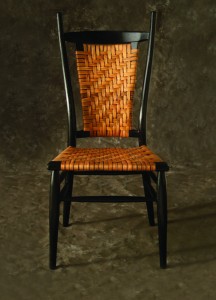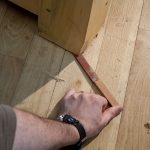We may receive a commission when you use our affiliate links. However, this does not impact our recommendations.
Free is good. Free and reputable is even better. Each month, one of the fun parts of my job is choosing the material for our free woodworking downloads. I dig through the Popular Woodworking archives and uncover the best stuff on particular topics – such as wood staining, the latest. I then work with our terrific designer to create a good-looking PDF for your desktop. It’s like being a kid in a candy store, only a kid who actually enjoys sharing his candy with others.
For the wood staining PDF, the only hard part was deciding the order to collate the articles. They tell you everything you need to know to advance your skills with wood stains.
Wood Staining – How Dark Can I Get That Chair?

Wood staining to the point of blackness is called ebonizing, a practice that dates back several centuries.
Wood staining has probably existed since the beginning of human civilization, in one form or another and in various colors. An interesting thing to remember, however, is the long-running quest for wood stain colors that are dark – as dark as possible. This practice emerged with the decline of ebony for woodworking. The less ebony for ébénistes (cabinet-makers) to use, the more their clients demanded dark wood stains that would make lighter woods look more like that favored dark stuff.
Many furniture buyers and woodworkers still equate dark with “rich,” true or deep. There’s a bit of a misconception that dark wood stains will accentuate grain patterns in the wood. Sometimes they do, sometimes they don’t. Usually that has more to do with how you use the stain, as well as finish choice and usage.
So as an extra for the wood staining PDF I wanted to offer a link to our 2009 Brian Boggs article (free) on ebonizing wood, in case you are looking to go deep. Brian has a pretty cool technique that involves an ingredient from the world of taxidermy. It looks simple to use. Give it a shot!
And be sure to browse the Popular Woodworking “candy stores” for our latest free and paid resources. There’s always something new in there!
Tell us your favorite wood stain colors and processes in the comments section below. Thanks!
–Dan Farnbach
Here are some supplies and tools we find essential in our everyday work around the shop. We may receive a commission from sales referred by our links; however, we have carefully selected these products for their usefulness and quality.









Great article. Brian talks about needing to mask the joints if the ebonizing is done before the project is assembled. Does the ebonizing process actually seal the pores of the wood so that the glue wouldn’t hold? It sounded like the process was really in the wood fibers that maybe did not seal the pores. Any thoughts?
Dan….thanks for posting this!